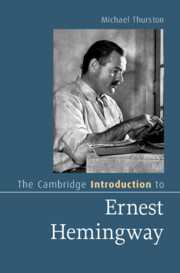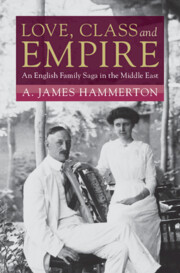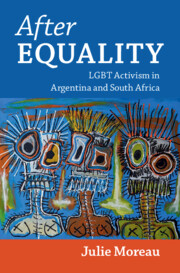Refine search
Actions for selected content:
495 results
Chapter 1 - Life
-
- Book:
- The Cambridge Introduction to Ernest Hemingway
- Print publication:
- 02 October 2025, pp 3-20
-
- Chapter
- Export citation
Chapter 8 - Reception
-
- Book:
- The Cambridge Introduction to Ernest Hemingway
- Print publication:
- 02 October 2025, pp 169-190
-
- Chapter
- Export citation

The Cambridge Introduction to Ernest Hemingway
-
- Expected online publication date:
- September 2025
- Print publication:
- 02 October 2025
5 - An Expatriate Marriage
-
- Book:
- Love, Class and Empire
- Published online:
- 10 July 2025
- Print publication:
- 04 September 2025, pp 136-178
-
- Chapter
- Export citation
Introduction
-
- Book:
- Love, Class and Empire
- Published online:
- 10 July 2025
- Print publication:
- 04 September 2025, pp 1-16
-
- Chapter
- Export citation
Chapter 5 - Love Your Neighbor (Leviticus 17–22)
-
- Book:
- The Theology of the Book of Leviticus
- Published online:
- 18 July 2025
- Print publication:
- 07 August 2025, pp 157-202
-
- Chapter
- Export citation
7 - Respectable Women
-
- Book:
- A Black Army
- Published online:
- 16 June 2025
- Print publication:
- 17 July 2025, pp 134-155
-
- Chapter
- Export citation

Love, Class and Empire
- An English Family Saga in the Middle East
-
- Published online:
- 10 July 2025
- Print publication:
- 04 September 2025
Chapter 9 - Women
- from Part II - Social Contexts
-
-
- Book:
- Sean O'Casey in Context
- Published online:
- 23 June 2025
- Print publication:
- 10 July 2025, pp 100-109
-
- Chapter
- Export citation
Chapter 8 - Censorship
- from Part II - Social Contexts
-
-
- Book:
- Sean O'Casey in Context
- Published online:
- 23 June 2025
- Print publication:
- 10 July 2025, pp 89-99
-
- Chapter
- Export citation
Chapter 19 - Eileen Carey (Eileen O’Casey)
- from Part III - Collaborators and Critics
-
-
- Book:
- Sean O'Casey in Context
- Published online:
- 23 June 2025
- Print publication:
- 10 July 2025, pp 202-211
-
- Chapter
- Export citation
Chapter 10 - Gender and Sexuality
- from Part II - Social Contexts
-
-
- Book:
- Sean O'Casey in Context
- Published online:
- 23 June 2025
- Print publication:
- 10 July 2025, pp 110-119
-
- Chapter
- Export citation
Introduction
-
- Book:
- Selling Sexual Knowledge
- Published online:
- 24 June 2025
- Print publication:
- 10 July 2025, pp 1-21
-
- Chapter
-
- You have access
- Open access
- HTML
- Export citation
Chapter 4 - Nerve Theory, Conditioned Reflex, and Literary Form
-
- Book:
- Samuel Beckett and Medicine
- Published online:
- 20 June 2025
- Print publication:
- 03 July 2025, pp 77-96
-
- Chapter
- Export citation

Selling Sexual Knowledge
- Medical Publishing and Obscenity in Victorian Britain
-
- Published online:
- 24 June 2025
- Print publication:
- 10 July 2025
-
- Book
-
- You have access
- Open access
- Export citation

After Equality
- LGBT Activism in Argentina and South Africa
-
- Published online:
- 19 June 2025
- Print publication:
- 03 July 2025
Conclusion
-
- Book:
- Stratification Economics and Disability Justice
- Published online:
- 21 June 2025
- Print publication:
- 05 June 2025, pp 134-142
-
- Chapter
- Export citation
Chapter 10 - Healthy Relationships
- from Section 3 - The Lifestyle Medicine Pillars
-
-
- Book:
- Essential Lifestyle Medicine
- Published online:
- 01 May 2025
- Print publication:
- 15 May 2025, pp 86-101
-
- Chapter
- Export citation
Chapter 8 - Sex, Kinship, and Other Freedom Practices
-
-
- Book:
- The Cambridge Companion to Mary Prince
- Published online:
- 24 April 2025
- Print publication:
- 08 May 2025, pp 135-151
-
- Chapter
- Export citation
Case 15 - A 40-Year-Old with Decreased Libido at 29 Weeks
- from Section 2 - Antepartum (Mid-trimester)
-
-
- Book:
- Pregnancy Complications
- Published online:
- 08 April 2025
- Print publication:
- 01 May 2025, pp 46-47
-
- Chapter
- Export citation
